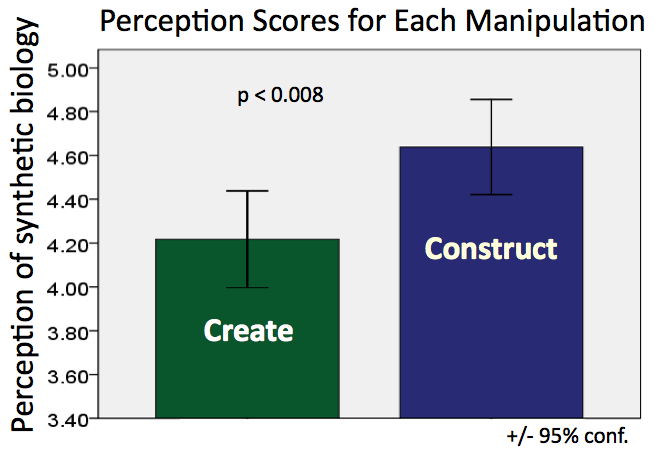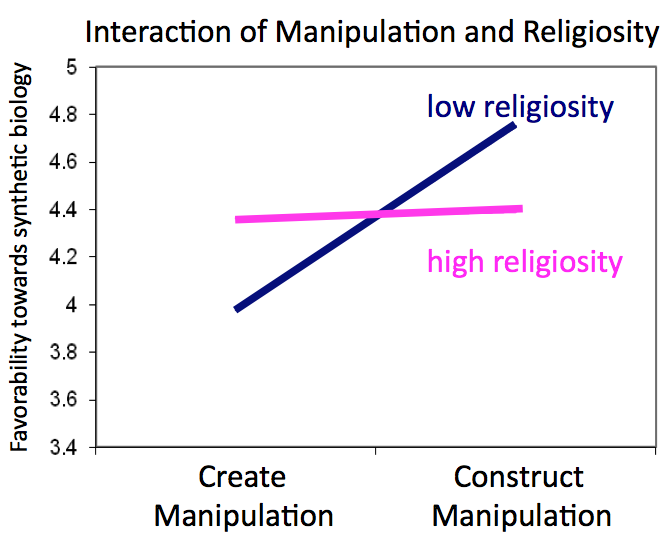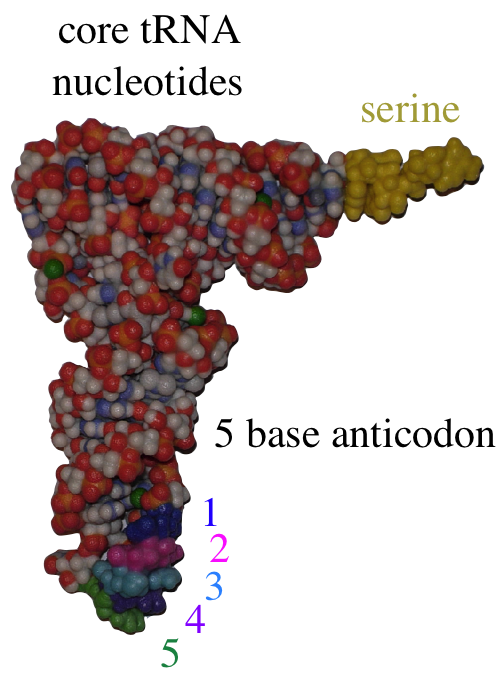Team:MoWestern Davidson/human practice
From 2009.igem.org
(→Survey) |
Macampbell (Talk | contribs) (→Data from the general public) |
||
| (38 intermediate revisions not shown) | |||
| Line 1: | Line 1: | ||
{{Template:MoWestern_Davidson2009}} | {{Template:MoWestern_Davidson2009}} | ||
| + | {| align="right" | ||
| + | | __TOC__ | ||
| + | |} | ||
== '''Survey''' == | == '''Survey''' == | ||
| - | Psychology | + | Sam Snell (Psychology major) and Kyri Bye-Nagel (Sociology Major) of Davidson College researched public opinion of synthetic biology based on provided summaries of the field. Through paper and online surveys, these students collected and analyzed responses from two groups: '''members of academia and the general public'''. |
| - | There was an | + | There was an assessment of those in academia to see how much is presently known about synthetic biology and its implementation in course curricula.''''' Here are the results of that study:''''' |
<center> | <center> | ||
| - | [[Image:survey_pic3.png| | + | [[Image:survey_pic3.png|Results of Teacher Survey|700x700px]] |
</center> | </center> | ||
The open response portion of the survey revealed that fewer than the reported percentage of faculty members could display adequate knowledge of synthetic biology. | The open response portion of the survey revealed that fewer than the reported percentage of faculty members could display adequate knowledge of synthetic biology. | ||
| - | Surveys given to general public were used to study public | + | Surveys given to general public were used to study public opinion based on the influence of different descriptions of synthetic biology. Two types of surveys were disseminated, and each version included a description that catered to a create perspective or a construct perspective. The participants’ prior knowledge of synthetic biology was measured before they were presented with the description. This study will provide information on the general public’s attitudes towards synthetic biology as well as their support for teaching synthetic biology in a high school classroom. There were also questions at the end of each survey concerning philosophical perspectives to see if there is a correlation between public opinion and personal beliefs. |
| - | Here are the descriptions provided on the surveys: | + | '''''Here are the descriptions provided on the surveys:''''' |
| - | ''' | + | '''Create perspective -''' |
| - | Synthetic biology uses molecular methods to create modified living organisms that have never existed before. These DNA-based devices perform new functions not found in nature. Synthetic biologists redesign and modify existing, natural biological systems. For instance, synthetic biologists can create new versions of microbes that make chemicals not naturally found in microbes. In many ways, synthetic biology allows scientists to redesign biological processes and create organisms not found in nature. Synthetic biology has the potential to develop technologies that could lead the way in the 21st century. | + | Synthetic biology uses molecular methods to create modified living organisms that have never existed before. These DNA-based devices perform new functions not found in nature. Synthetic biologists redesign and modify existing, natural biological systems. For instance, synthetic biologists can create new versions of microbes that make chemicals not naturally found in microbes. In many ways, synthetic biology allows scientists to redesign biological processes and create organisms not found in nature. Synthetic biology has the potential to develop technologies that could lead the way in the 21st century. |
| - | ''' | + | '''Construct perspective -''' |
Synthetic biology uses molecular methods to construct DNA-based devices to perform novel functions. Synthetic biologists design, model and construct biological parts, devices and systems by engineering and modifying existing biological systems. For instance, synthetic biologists can produce microbes that make useful chemicals. Synthetic biology gives scientists the tools to build biological devices from smaller biological units in much the same way as an engineer constructs a building from smaller construction materials. Synthetic biology has the potential to develop technologies that could lead the way in the 21st century. | Synthetic biology uses molecular methods to construct DNA-based devices to perform novel functions. Synthetic biologists design, model and construct biological parts, devices and systems by engineering and modifying existing biological systems. For instance, synthetic biologists can produce microbes that make useful chemicals. Synthetic biology gives scientists the tools to build biological devices from smaller biological units in much the same way as an engineer constructs a building from smaller construction materials. Synthetic biology has the potential to develop technologies that could lead the way in the 21st century. | ||
| - | Data from the general public | + | ===Data from the general public=== |
| + | Citizens in North Carolina were randomly assigned to one of two groups. One group used the word "create" and similar terms to see if this had an impact on their view of synthetic biology. The other group used words such as "build", "construct", etc. (See full description above.) | ||
| + | <center> | ||
| + | [[Image:manipulate.png]] | ||
| + | </center> | ||
| + | We also measured each person's "religiosity" and analyzed the impact religiosity had on the manipulation. We found that more religious people were not influenced by the manipulation of create and construct which did not match our expectations. In fact, those who were in the low religiosity scale where much significantly influenced by the manipulation. | ||
| + | <center> | ||
| + | [[Image:religion.png]] | ||
| + | </center> | ||
| + | |||
| + | '''Data from faculty''' | ||
| + | Faculty at high schools and colleges/universities from across the country were asked how much they presently know about synthetic biology and its implementation in course curricula. The survey revealed that 16% of college faculty reported adequate knowledge of synthetic biology while only 8% of high school teachers reported adequate knowledge of the field. Surveys given to general public were used to study public opinion based on the influence of different descriptions of synthetic biology. | ||
| + | |||
| + | Teachers and professors who currently teach synthetic biology believe that lab kits and associated curriculum, lecture and test materials, and student-friendly research papers highly influence their ability to teach synthetic biology to their students. High school teachers further believe that workshop experiences and modeling activities would help them. Only 1 of 10 high school teachers believe connection to state or national curriculum standards help them teach the discipline. Of particular interest, high school teachers strongly believe that lab kits and access to ways to broaden their knowledge help them teach synthetic biology. | ||
== '''Physical Modeling as an Educational Tool''' == | == '''Physical Modeling as an Educational Tool''' == | ||
| + | We designed a 3-D physical model, shown here, of a 5-base anticodon frameshift suppressor tRNA. The model was built in collaboration with the [http://www.rpc.msoe.edu/cbm/ Center for BioMolecular Modeling] at the Milwaukee School of Engineering. The model serves as an educational tool that we can use to explain the process of frameshift suppression as it relates to our bacterial computer project. It demonstrates how frameshift suppressor tRNA anticodons interact with a strand of mRNA and how, despite their modification, they maintain the structure and function of a normal tRNA. At the iGEM Jamboree, we hope to attract interest in our model and have the opportunity to share it with our fellow teams. We plan to use the model to illustrate the usefulness of physical models to communicate important structural aspects of a synthetic biology project and to promote a new connection between the iGEM community and the Center for Biomolecular Modeling. More information is available on our [[Team:MoWestern Davidson/project physicalmodel|physical models]] page. <br><center> | ||
| + | [[Image:clean_tRNA.png]] | ||
| + | </center> | ||
{{Template:MoWestern_Davidson2009_end}} | {{Template:MoWestern_Davidson2009_end}} | ||
Latest revision as of 22:40, 15 November 2009

|
Survey
Sam Snell (Psychology major) and Kyri Bye-Nagel (Sociology Major) of Davidson College researched public opinion of synthetic biology based on provided summaries of the field. Through paper and online surveys, these students collected and analyzed responses from two groups: members of academia and the general public.
There was an assessment of those in academia to see how much is presently known about synthetic biology and its implementation in course curricula. Here are the results of that study:
The open response portion of the survey revealed that fewer than the reported percentage of faculty members could display adequate knowledge of synthetic biology.
Surveys given to general public were used to study public opinion based on the influence of different descriptions of synthetic biology. Two types of surveys were disseminated, and each version included a description that catered to a create perspective or a construct perspective. The participants’ prior knowledge of synthetic biology was measured before they were presented with the description. This study will provide information on the general public’s attitudes towards synthetic biology as well as their support for teaching synthetic biology in a high school classroom. There were also questions at the end of each survey concerning philosophical perspectives to see if there is a correlation between public opinion and personal beliefs.
Here are the descriptions provided on the surveys:
Create perspective - Synthetic biology uses molecular methods to create modified living organisms that have never existed before. These DNA-based devices perform new functions not found in nature. Synthetic biologists redesign and modify existing, natural biological systems. For instance, synthetic biologists can create new versions of microbes that make chemicals not naturally found in microbes. In many ways, synthetic biology allows scientists to redesign biological processes and create organisms not found in nature. Synthetic biology has the potential to develop technologies that could lead the way in the 21st century.
Construct perspective - Synthetic biology uses molecular methods to construct DNA-based devices to perform novel functions. Synthetic biologists design, model and construct biological parts, devices and systems by engineering and modifying existing biological systems. For instance, synthetic biologists can produce microbes that make useful chemicals. Synthetic biology gives scientists the tools to build biological devices from smaller biological units in much the same way as an engineer constructs a building from smaller construction materials. Synthetic biology has the potential to develop technologies that could lead the way in the 21st century.
Data from the general public
Citizens in North Carolina were randomly assigned to one of two groups. One group used the word "create" and similar terms to see if this had an impact on their view of synthetic biology. The other group used words such as "build", "construct", etc. (See full description above.)
We also measured each person's "religiosity" and analyzed the impact religiosity had on the manipulation. We found that more religious people were not influenced by the manipulation of create and construct which did not match our expectations. In fact, those who were in the low religiosity scale where much significantly influenced by the manipulation.
Data from faculty Faculty at high schools and colleges/universities from across the country were asked how much they presently know about synthetic biology and its implementation in course curricula. The survey revealed that 16% of college faculty reported adequate knowledge of synthetic biology while only 8% of high school teachers reported adequate knowledge of the field. Surveys given to general public were used to study public opinion based on the influence of different descriptions of synthetic biology.
Teachers and professors who currently teach synthetic biology believe that lab kits and associated curriculum, lecture and test materials, and student-friendly research papers highly influence their ability to teach synthetic biology to their students. High school teachers further believe that workshop experiences and modeling activities would help them. Only 1 of 10 high school teachers believe connection to state or national curriculum standards help them teach the discipline. Of particular interest, high school teachers strongly believe that lab kits and access to ways to broaden their knowledge help them teach synthetic biology.
Physical Modeling as an Educational Tool
We designed a 3-D physical model, shown here, of a 5-base anticodon frameshift suppressor tRNA. The model was built in collaboration with the [http://www.rpc.msoe.edu/cbm/ Center for BioMolecular Modeling] at the Milwaukee School of Engineering. The model serves as an educational tool that we can use to explain the process of frameshift suppression as it relates to our bacterial computer project. It demonstrates how frameshift suppressor tRNA anticodons interact with a strand of mRNA and how, despite their modification, they maintain the structure and function of a normal tRNA. At the iGEM Jamboree, we hope to attract interest in our model and have the opportunity to share it with our fellow teams. We plan to use the model to illustrate the usefulness of physical models to communicate important structural aspects of a synthetic biology project and to promote a new connection between the iGEM community and the Center for Biomolecular Modeling. More information is available on our physical models page.
 "
"



